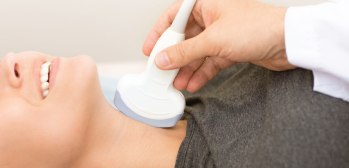 TRIO Best Practice articles are brief, structured reviews designed to provide the busy clinician with a handy outline and reference for day-to-day clinical decision making. The ENTtoday summaries below include the Background and Best Practice sections of the original article. To view the complete Laryngoscope articles free of charge, visit Laryngoscope.
TRIO Best Practice articles are brief, structured reviews designed to provide the busy clinician with a handy outline and reference for day-to-day clinical decision making. The ENTtoday summaries below include the Background and Best Practice sections of the original article. To view the complete Laryngoscope articles free of charge, visit Laryngoscope.
Explore This Issue
December 2020Background
Thyroid nodules have a prevalence of 19% to 68% in the general population, with only 7% to 15% harboring thyroid cancer (Endocrine. 2019;64:90-96; J Clin Endocrinol Metab. 2019;104:95-102). Ultrasound (US) is now the primary radiologic tool for evaluating thyroid nodules, with several US features being predictive of malignancy risk and therefore able to guide when a fine needle aspiration (FNA) biopsy may be advisable. Multiple medical specialty societies across the world have developed US-based thyroid nodule risk stratification guidelines, in part to curb the significant testing and possible overtreatment of millions of benign thyroid nodules. A key feature of the guidelines is to identify nodules with low risk of malignancy whose cytologic assessment with FNA can be safely deferred (J Clin Endocrinol Metab. 2019;104:95-102; Radiology. 2018;287:893-900). Differences among the guidelines include the US lexicon, risk stratification category, quantitative versus qualitative grouping, and FNA nodule size thresholds (Endocrine. 2019;64:90-96; J Clin Endocrinol Metab. 2019;104:95-102; Radiology. 2018;287:893-900; Am J Roentgenol. 2019;213:W76-84; Thyroid. 2018;28:1532-1537). Few studies have compared the different guidelines to determine which is best at identifying high-risk nodules or thyroid cancers while minimizing “unnecessary” thyroid biopsies. Authors chose to compare studies that assessed large cohorts of thyroid nodules with known outcomes, had a blinded US review, and then applied various classification systems to see which performed best. Within these investigations, “unnecessary” thyroid biopsies are defined as biopsies that would have been indicated by the particular classification system and ultimately turned out to be benign, either by cytology or histology. Authors focused on the guidelines’ negative predictive value (NPV), representing the probability that a nodule is benign. They also looked at the rate of unnecessary FNAs and the probability that a nodule not selected for FNA was malignant (false negative rate (FNR)). They sought to clarify which classification performed best with respect to NPV, unnecessary biopsy rate, and FNR. Since most guidelines have a size threshold of 1 cm for FNA, this review only applied to thyroid nodules ≥1 cm.
Best Practice

© Lightspring / shutterstock.com
Although all guidelines noted have relatively high NPV, the American College of Radiology Thyroid Image Reporting and Data System (ACR-TI-RADS) performed best at identifying nodules ≥1 cm that could safely avoid biopsy while demonstrating the lowest number of unnecessary FNAs. In addition, the ACR-TI-RADS is unique among the other guidelines in that it is a point-based rather than a pattern-based system, favoring a synoptic report to make the decision easier for the individual physician. Therefore, universal application of this system could potentially result in less variability of the US interpretation of thyroid nodules across providers and institutions. Authors recognize the limitation of these studies due to the application of the classification systems to retrospective datasets, which can introduce the possibility of selection bias. However, the blinded nature of the sonographic assessment helps to minimize this issue. Using such classification schemes can help introduce evidence-based decision-making in thyroid nodule management to reduce personal bias and potential unnecessary overtreatment. Future studies will be needed to determine performance consistency across different interpreting physicians and validate the results in a prospective manner.